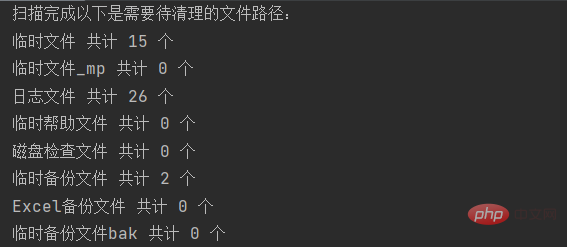Maison >développement back-end >Tutoriel Python >Comment écrire un outil de nettoyage des ordures sur le lecteur C en Python
Comment écrire un outil de nettoyage des ordures sur le lecteur C en Python
- WBOYWBOYWBOYWBOYWBOYWBOYWBOYWBOYWBOYWBOYWBOYWBOYWBavant
- 2023-04-24 13:13:071694parcourir
关于python的文件清理操作,实际上我们使用标准模块os即可满足所有的文件操作。
一般在C盘的清理过程中,我们能够清理的文件类型主要如下:
'''
'.tmp': '临时文件',
'._mp': '临时文件_mp',
'.log': '日志文件',
'.gid': '临时帮助文件',
'.chk': '磁盘检查文件',
'.old': '临时备份文件',
'.xlk': 'Excel备份文件',
'.bak': '临时备份文件bak'
'''既然已经知道了需要清理的文件类型,那实现思路就是将这些文件找出来后删除掉即可。
将我们接下来代码块中使用到的os标准模块直接导入到代码块中。
# Importing the os module. import os
现在可以将一些全局变量首先定义好,比如全局的系统操作路径、待清理的文件后缀名等等。
# 待清理的文件后缀名称
suffix_dict = {
'.tmp': '临时文件',
'._mp': '临时文件_mp',
'.log': '日志文件',
'.gid': '临时帮助文件',
'.chk': '磁盘检查文件',
'.old': '临时备份文件',
'.xlk': 'Excel备份文件',
'.bak': '临时备份文件bak'
}
# 用户缓存数据类型名称
user_profile_list = [
'cookies', 'recent', 'Temporary Internet Files', 'Temp'
]
# windows系统路径文件类型
windir_list = [
'prefetch', 'temp'
]
# 系统驱动路径
sys_drive = os.environ['systemdrive'] + '\\'
# 用户缓存路径
user_profile = os.environ['userprofile']
# windows系统路径
win_dir = os.environ['windir']以上相关的C盘清理的全局变量已经设置完成了,接下来我们创建一个ClaenFilesUtil的类来完成对文件清理的业务操作过程。
# This class is used to clean up files in a directory
class CleanFilesUtil():
def __init__(self):
"""
A constructor. It is called when an object is created from a class and it allows the class to initialize the
attributes of a class.
"""
self.del_info = {}
self.del_file_paths = []
self.total_size = 0
for suffix_name, comment in suffix_dict.items():
self.del_info[suffix_name] = dict(name=comment, count=0)
def scanf_files(self):
"""
It takes a list of files, and returns a list of lists of the lines in each file
"""
for roots, dirs, files in os.walk(user_profile):
for files_item in files:
file_extension = os.path.splitext(files_item)[1]
if file_extension in self.del_info:
file_full_path = os.path.join(roots, files_item)
self.del_file_paths.append(file_full_path)
self.del_info[file_extension]['count'] += 1
self.total_size += os.path.getsize(file_full_path)
def show_count_message(self):
"""
It prints the number of messages in the inbox.
"""
byte = self.format_size(self.total_size)
for i in self.del_info:
print(self.del_info[i]["name"], "共计", self.del_info[i]["count"], "个")
return byte
def format_size(self, byte):
"""
It takes a number of bytes and returns a string with the number of bytes, kilobytes, megabytes, or gigabytes,
depending on the size
:param byte: The size in bytes
"""
try:
kb = byte // 1024
except:
print("传入字节格式不对")
return "Error"
if kb > 1024:
M = kb // 1024
if M > 1024:
G = M // 1024
return "%dG" % G
else:
return "%dM" % M
else:
return "%dkb" % kb
def remove_file_or_dir(self):
"""
> This function removes a file or directory
"""
for full_path_one in self.del_file_paths:
try:
if os.path.isfile(full_path_one):
os.remove(full_path_one)
print("文件:", full_path_one, "已移除")
elif os.path.isdir(full_path_one):
os.rmdir(full_path_one)
print("文件夹", full_path_one, "已移除")
except WindowsError:
print("错误:", full_path_one, "不能被移除")
if __name__ == "__main__":
print("开始初始化C盘清理程序")
clean_ = CleanFilesUtil()
print('C盘清理程序初始化完成')
print("开始扫描所有待清理文件路径")
clean_.scanf_files()
print("完成所有待清理文件路径扫描")
print("扫描完成以下是需要待清理的文件路径:")
clean_.show_count_message()
print("开始执行C盘垃圾文件删除")
clean_.remove_file_or_dir()
print("所有C盘垃圾文件已清理完成")
input("输入任意键关闭窗口...")于是,我想到了前几天发布的文章[python不要再使用while死循环,使用定时器代替效果更佳!],可以通过定时器的方式来满足业务要求。
除了使用代码块来完成定时还可以通过配置windows或其他操作系统的定时任务来完成定时执行的需求。

Ce qui précède est le contenu détaillé de. pour plus d'informations, suivez d'autres articles connexes sur le site Web de PHP en chinois!
Déclaration:
Cet article est reproduit dans:. en cas de violation, veuillez contacter admin@php.cn Supprimer
Article précédent:Les performances de Python 3.11 se sont améliorées de près de 64 % !Article suivant:Les performances de Python 3.11 se sont améliorées de près de 64 % !

